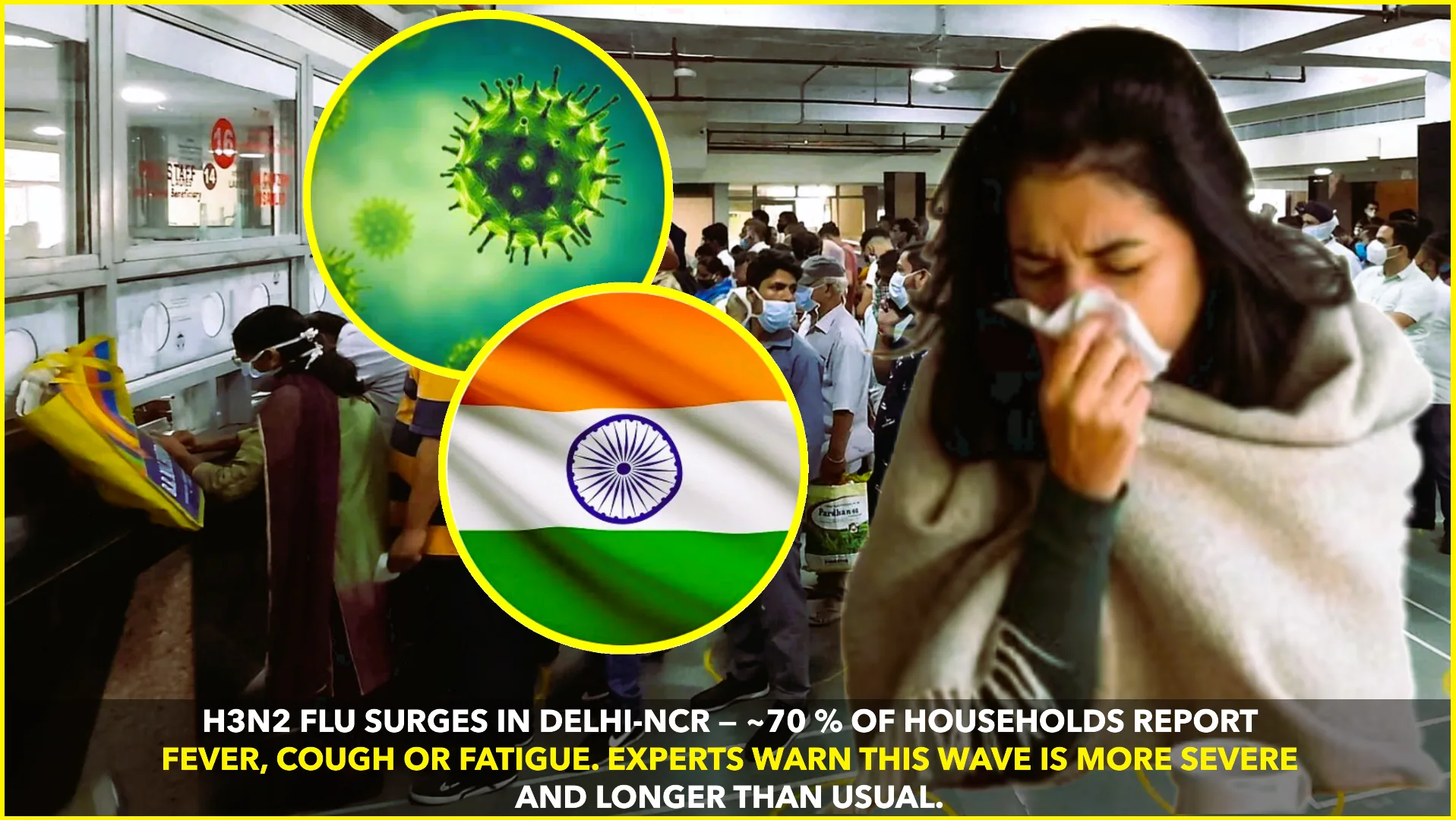The Spread Across Delhi-NCR and India
A widespread H3N2 flu outbreak, blamed for a sudden spike in flu-like illnesses, is gripping Delhi-NCR. According to a LocalCircles survey of over 11,000 households across Delhi, Noida, Gurugram, Faridabad, and Ghaziabad, nearly 70 % of households report at least one person suffering from symptoms like fever, cough or fatigue—up from baseline seasonal levels The Logical Indian+2The Indian Express+2.
While regional reports confirm that this wave has extended beyond Delhi-NCR to other regions like Pune and Kolkata, the epicenter remains Delhi-NCR, where clinics and hospitals are inundated with patients exhibiting high-grade fever, persistent cough, body aches and exhaustion The Times of India+2The Indian Express+2.
Why This Wave Is Different: Severity and Duration
Unlike a typical seasonal flu, this H3N2 outbreak shows more intense and prolonged symptoms. Many patients report symptoms lasting beyond 10 days, far longer than the usual 5–7 days of recovery The Economic Times+1. Medical professionals warn that over-the-counter remedies like paracetamol are often insufficient to bring the fever down, and some cases have required antiviral treatment The Economic Times+2The Times of India+2.
Notably, young and middle-aged adults, particularly professionals under 40, are being hit hard due to dense working environments and reluctance to take sick leave. One case featured a 38-year-old software engineer with a stubborn 104 °F fever and severe fatigue lasting weeks The Indian Express.
High-risk groups—including children, the elderly, pregnant women, and those with chronic illnesses like asthma, diabetes, or heart disease—are especially vulnerable to complications such as pneumonia or bronchitis The Economic Times+2Care Health Insurance+2.
Recognizing Common Signs
Typical H3N2 symptoms include:
- Sudden high fever and chills
- Severe sore throat, persistent cough
- Headaches, muscle and body aches, fatigue
- Nasal congestion or runny nose
- In children: nausea, vomiting, diarrhea The Times of India+2Sarvodaya Healthcare+2
Early difficulty breathing, chest pain, bluish lips or nails, confusion, dizziness, or severe dehydration are red-flag signs demanding immediate medical attention The Indian Express+2The Times of India+2.
How It Spreads
H3N2, a subtype of Influenza A marked by haemagglutinin type 3 and neuraminidase type 2 (hence “H3N2”), spreads swiftly through:
- Respiratory droplets expelled while talking, coughing or sneezing
- Touching virus-laden surfaces and then touching face, nose, or eyes
- Crowded and poorly ventilated indoor spaces like offices or AC rooms Sarvodaya Healthcare+1
Once introduced into a household—especially in high-density living areas—transmission to other members happens quickly.
Expert Recommendations & Prevention Advice
Health authorities and medical experts are urging immediate, coordinated action:
- Get tested early via nasal or throat swab or rapid influenza test if flu-like symptoms emerge.
- Isolate symptomatic individuals, especially in household settings, to avoid transmission.
- Maintain high hygiene standards: wash hands frequently for at least 20 seconds, disinfect shared surfaces, avoid sharing utensils, towels or bedding The Times of India+2The Logical Indian+2.
- Wear masks in crowded or enclosed spaces.
- Ensure proper ventilation indoors.
- Monitor hydration and rest: fluids, warm soups, sleep and nourishment support recovery.
- Seek medical care if symptoms worsen—fever doesn’t subside, breathing issues emerge, chest pain develops, or underlying conditions are at risk. Some may be prescribed antiviral drugs like oseltamivir within 48 hours of symptom onset The Times of India+2The Logical Indian+2.
- Flu vaccination: The 2025–26 seasonal flu vaccine includes protection against H3N2—it is especially recommended for everyone over six months, with priority given to high-risk individuals The Times of India+2The Logical Indian+2.
At-Home Recovery Tips
Most people with mild symptoms can recover at home by:
- Resting for at least 7–10 days
- Staying well-hydrated
- Using medications like paracetamol for fever and pain only under medical guidance
- Avoiding self-medication with antibiotics, which do not work against viral infections The Times of India+1
Children and older individuals should be monitored carefully for any signs of breathing difficulty or dehydration.
Why This Matters
This current spike in H3N2 flu cases in Delhi-NCR is both more widespread and more persistent than typical seasonal flu seasons. With almost 70 % of households impacted, the outbreak has overwhelming potential to strain healthcare resources and disrupt daily life, especially among working individuals and vulnerable groups.
Timely diagnosis, isolation of cases, routine hygiene measures, mask-wearing, and vaccination remain the strongest tools to slow transmission and reduce severity. Experts emphasize community effort: if symptomatic, prioritize rest and medical care—don’t push through illness at work.
By staying alert, seeking early medical advice, and following simple preventive habits, individuals can protect themselves and their communities from this aggressive H3N2 flu wave.










